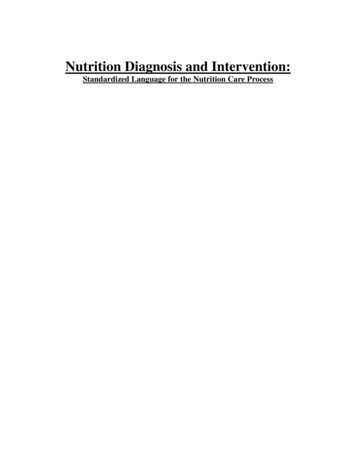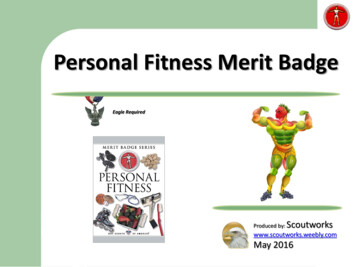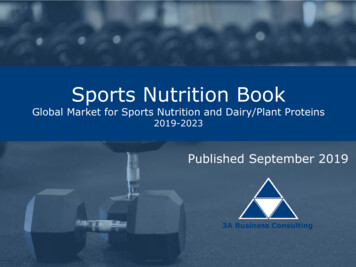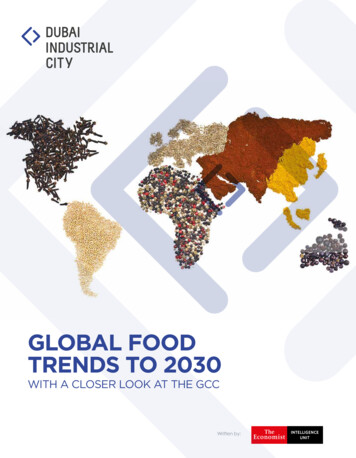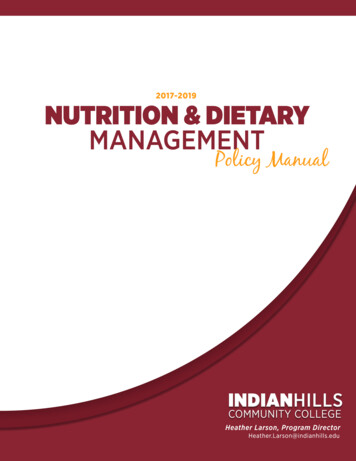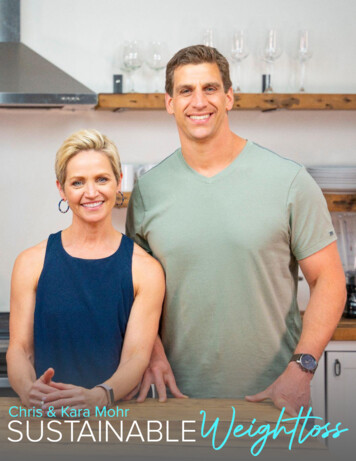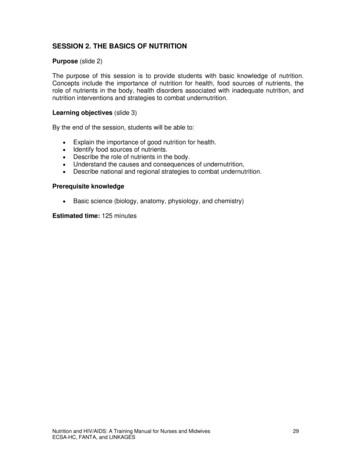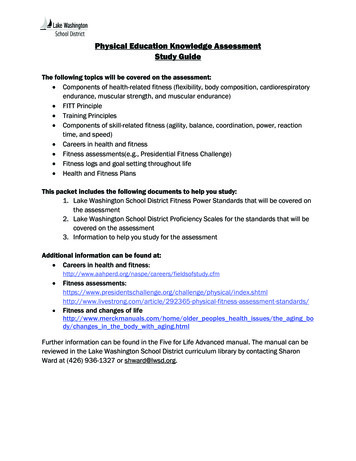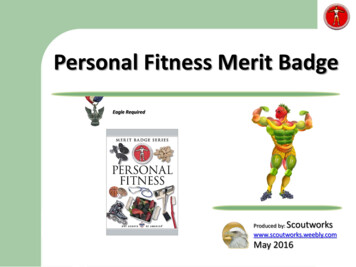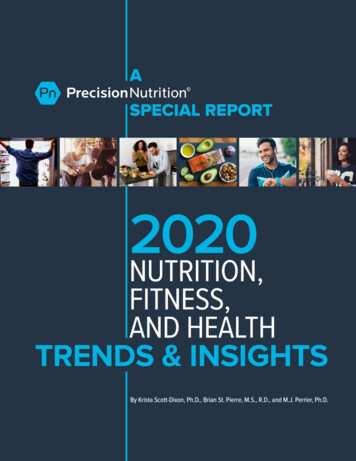
Transcription
A SPECIAL REPORT2020NUTRITION,FITNESS,AND HEALTHTRENDS & INSIGHTSBy Krista Scott-Dixon, Ph.D., Brian St. Pierre, M.S., R.D., and M.J. Perrier, Ph.D.
TABLE OF CONTENTS5 TOP NUTRITION CHALLENGES11 TOP HEALTH AND FITNESS GOALS15 EATING AT HOME VERSUS DINING OUT18 HEALTHY EATING HABITS22 BIGGEST EXERCISE CHALLENGE27 SLEEP HABITS:WHAT’S HAPPENING AT NIGHT2
3
Over the last decade, Precision Nutrition has helped morethan 100,000 people make healthy eating and lifestyle changes.As a data driven company, we carefully track every detail of our clients’progress, from beginning to end. The starting point: a robust intakequestionnaire to gain a better understanding of where people need themost help. Because data are better than assumptions.This information allows us to better serve each person individually.But collectively, these data—gleaned from thousands of incoming clientsannually—reveal the biggest obstacles between most people and theirhealth and fitness goals in the coming year.Every year, we use these findings—combined with our professional coachingexperience and the latest nutrition and behavior-change science—to developmore effective solutions. We then test our solutions with thousands ofreal clients and our network of Precision Nutrition certified coaches.(To date, we’ve trained over 70,000 health and fitness professionals.)The result: an ever-evolving program that dramatically transforms livesthrough healthy eating and lifestyle changes.In this report, we’ve aggregated this year’s key findings—and providedtargeted solutions—to help you better serve your clients. If you’re interestedin learning more about the precision nutrition coaching methods, checkout our Level 1 Certification. It’ll provide you with the skills, knowledge,and confidence you need to successfully coach nutrition—in one complete,proven system. (Join our presale list to lock-in a special discount.)4
THE TOPNUTRITIONCHALLENGESSurprise: “I don’t know what to eat”doesn’t even crack the top 10.The biggest problem with trying to eat healthier?There’s not just one problem. When you ask thousands of people“what’s your biggest nutrition challenge”—and tell them to select any that apply—they check a lot of boxes.The good news: You see which problems are the most common.In the charts below, we’ve combined the responses ofwomen and men to give you the overall results,but also broken out the top 5 nutrition challenges for both groups.5
THE TOP NUTRITION CHALLENGESTHE TOP 10NUTRITION CHALLENGESWe asked:What’s your biggest nutrition challenge?6
THE TOP NUTRITION CHALLENGESTHE TOP 5THE TOP 5 NUTRITIONCHALLENGES:NUTRITIONCHALLENGES:WOMEN &&MENWOMENMENWomen:Emotional / stress eating70.2%57.4%Snacking when not hungry54.3%Lack of planningCravings53.3%Sweet tooth52.9%Men:Eating quickly59.9%55.2%Lack of planningEating out frequently50.0%Large portions49.4%Cravings48.9%7
THE TOP NUTRITION CHALLENGESKEY TRENDSIN THELAST 5 YEARS8
THE TOP NUTRITION CHALLENGESthe takeaways1Emotional and stress eating is a key focus area. It’s the #1 nutritionchallenge for women, and trending that way for men. This behavior isoften triggered by a person’s environment and pastexperiences. We’ve created a detailed guide for dealing with thisfrustrating problem: Conquer Your Cravings: Break the Sinister CycleThat Makes You Overeat.2Alcohol intake is on the rise. We’ve seen a statisticallysignificant uptick over the last 5 years. We all know this can be a stresscoping mechanism, and while a daily drink can help you unwind, it’simportant not to become over-reliant on it. Our writer investigated animportant question: Would You Be Healthier If You Quit Drinking?3Modern foods have created new challenges. “Snacking when nothungry,” a trending problem for both women and men, wasn’t likely anissue for our ancestors. A major reason for its surge: The availability ofconvenient and delicious foods manufactured to be “hyperpalatable.”Read our full report on these foods here: Manufactured Deliciousness:Why You Can’t Stop Overeating.9
THE TOP NUTRITION CHALLENGES4Another new diet isn’t the answer. According to our research, mostfolks tend to know the kinds of foods they should eat. They understandthey’re eating too much. And they realize they should plan their mealsbetter. They’re just not doing it.Which is why quick-fix diets are often long-term fails. It’s not about thediet; they all “work.” Lasting change is about behavior. If you can identifywhere your behavior needs to change, you can practice and ingrain newhabits to replace the old ones.Here at Precision Nutrition, we concluded this years ago—based on clientdata, scientific evidence, and professional experience—and restructuredour entire program to focus on what really matters: providing people withthe tools and skills they need to consistently practice healthy eating andlifestyle habits (no matter what diet they adopt). So that they becomesecond nature, and drive meaningful results that last.For a complete look at how our approach applies to these nutritionchallenges, packed with behavior-change resources from the PN team,see: How to Overcome the 8 Biggest Diet Challenges.MORE RESOURCES FROM PRECISION NUTRITION The 30-Day Eating Challenge That Might Blow Your Mind—and TransformYour Body ‘What Foods Should I Eat!?’ Our 3-Step Guide to Choosing the Best Foodsfor Your Body10
THE TOPHEALTH & FITNESSGOALSEveryone just wants to lose weight, right?Not according to our clients.People want to “look better,” sure. That’s human nature.But turns out, losing weight alone isn’t their number one motivator.11
THE TOP HEALTH & FITNESS GOALSKEY TRENDTO WATCHOver the last 5 years,weight loss has becomea greater priority for menthan adding muscle,which ranked higherthan “lose weight”in both 2015 and 2016.12
THE TOP HEALTH & FITNESS GOALSWHAT DO PEOPLE REALLYWANT TO ACHIEVE?We asked:What are your health and fitness priorities?Rank them from 1 to 10. (You could rank them all 10, if desired.)13
THE TOP HEALTH & FITNESS GOALSthe takeaways1Most people want more than just weight loss. They want tomake meaningful progress, and they want to maintain their results.Ultimately, they want change that lasts and are interested in learninghow to achieve that.2There’s missing information that data can’t reveal. We knowthis from coaching over 100,000 clients. While people do want to lookbetter, “gettings abs” or “dropping two sizes” is rarely their truemotivation. The real question: Why do they want to look and feel better?Often, there’s a more profound purpose driving the people who achieveamazing transformations. Left to their own devices, most folks mightnever even realize the real reason they want to change. But asking theright questions—so that they verbalize their “why”—can allow them totap into a powerful source of motivation.We detail the process here: Forget Bikini Bodies and Big Arms:Here’s the Real Secret for Getting Motivated to Transform Your Body.14
EATING AT HOMEVERSUSDINING OUTLet’s look at where people are getting their mealsMost people eat out (or order in), on average,at least once every other day. That’s the 21st Century for you,and we don’t expect to see a downward trend any time soon.15
EATING AT HOME VERSUS DINING OUTKEY TRENDSTO WATCH16
EATING AT HOME VERSUS DINING OUTthe takeaways1People need easy ways to prepare nutritious meals. Our datahints at this, but this takeaway is also based on direct feedback clientshave given our coaches. Here’s a matrix we use—featuring deliciousbut simple cooking techniques—to help clients build a bigger menu ofhealthy meals: Create the Perfect Meal with This 5-Step Guide.2Restaurants aren’t going away. For some people, cutting outrestaurants—and making all their meals at home instead—is just toobig of an adjustment to make. And certainly too big to make overnight.So it’s often impractical advice. A more effective solution: providingpeople with ways they can eat “just a little better,” no matter wherethey are. This approach also helps with “lack of planning,” one of thebiggest nutrition challenges cited by both women and men. See howto use this strategy here.MORE RESOURCES FROM PRECISION NUTRITION 25 Ways to Eat Well On-the-Go17
HEALTHYEATING HABITS:PLANT FOODSAND PROTEINPeople may know what’s good for them,but do they really believe it?It’s certainly not new advice to tell people toeat more fruits and vegetables, and boost their protein intake.This has been promoted by many top diet experts and the health mediafor the last two decades. Has the message been received?18
HEALTHY EATING HABITS: PLANT FOODS AND PROTEINKEY TRENDSOVER THELAST 5 YEARS19
HEALTHY EATING HABITS: PLANT FOODS AND PROTEINthe takeaways1Some people just don’t like produce. We frequently hear this directlyfrom clients, especially when it comes to vegetables. One way toencourage a greater vegetable intake? Make them taste better, using foodscience. Read: What to Do When You Don’t Like Vegetables.20
HEALTHY EATING HABITS: PLANT FOODS AND PROTEIN2Many people aren’t eating enough protein. The data here supportsthis as a possibility, but we also know it based on our experiencecoaching clients. This isn’t to suggest these folks are deficient, but thatmost people aren’t eating an optimal amount for their goals. For example,their lower intake may be having a negative impact on appetite control,which makes weight loss harder.In our extensive work with clients, we’ve seen that adding more protein topeople’s diets reduces their hunger between meals (a finding that’s alsosupported by research). The result: People start eating fewer calorieswithout actively trying to, making greater protein consumption a key habitfor driving better results.In fact, we’ve found this approach of adding “good stuff” is much morepowerful for weight loss than simply subtracting the “bad stuff.” Wantto learn more? Read: How Much Protein Should You Eat? Choose theRight Amount for Fat Loss, Muscle, and Health.21
BIGGESTEXERCISECHALLENGEFair warning: This is the least shocking data yet.There’s plenty that men and women don’t agree on, but when it comesto exercise obstacles, they’re in lock step with each other.22
BIGGEST EXERCISE CHALLENGETHE TOP 3 BARRIERSTO EXERCISEWe asked:What’s your biggest exercise challenge? The thingthat makes it difficult for you to stay consistent ormake progress with exercise?23
BIGGEST EXERCISE CHALLENGEKEY TRENDTO WATCHThe alarming trend hereis that there’s no trend.From year to year,we see the same responses.Meaning: People aren’t findingsolutions to these problemson their own and,without help, will continueto struggle in this area.24
BIGGEST EXERCISE CHALLENGEthe takeawaysPeople are busy and lead hectic lives. This is one factor that’s unlikely tochange. (Maybe ever.) So what can a person do? It starts with a simplequestion: If you can’t totally remove a barrier, how could you work aroundit? We’ve come up with two key ways:1Helping clients focus on progress, not perfection. Instead of goingfor the ideal on day one, you simply try to do a little better.For example, if you’re not exercising at all right now, that might meancommitting to 5 minutes a day of working out. Does that sound ridiculouslyeasy? Good. That’s what we want.The reason: Our data shows consistency is the number one factor forachieving meaningful results. We present our full case here: Nearly OneMillion Data Points Show What It REALLY Takes to Lose Fat, Get Healthy,and Change Your Body.25
BIGGEST EXERCISE CHALLENGE2Helping clients eliminate the all-or-nothing mindset. You knowhow this goes (because everybody knows how this goes): You’releaving for the gym just as the dog throws up on the carpet. Or yousnap a shoestring. Or your gabby neighbor catches you in the driveway.Your workout is now worthless, you think, even though it’s really only a5- or 10-minute delay. So you bag the whole thing, and aim to start freshtomorrow. (The problem: You never know what’ll happen then, either.)We tell our clients: Forget all-or-nothing; strive for “always something.”This mindshift change takes practice, and we show you how in this article:Why the Pause-Button Mentality Is Ruining Your Health and Fitness.26
SLEEP HABITS:WHAT’S HAPPENINGAT NIGHT?Plenty of people are waking upon the wrong side of the bedProper rest and recovery are critical for many reasons.But simply put, lack of quality sleep makes everything harder:jobs, relationships, and, yes, nutrition, health, and fitness goals.Here’s what our clients are saying about sleep.27
SLEEP HABITS: WHAT’S HAPPENING AT NIGHT?KEY SLEEP TRENDSTO WATCH28
SLEEP HABITS: WHAT’S HAPPENING AT NIGHT?the takeaways1Most people aren’t getting a restful night’s sleep. And that’s trueeven among those who regularly get 7 to 9 hours of shuteye. This is oftendue to a combination of factors, including stress, nighttime routine, andsleep environment. And most important: Not only understanding all of this,but making a consistent effort to address it. Here’s a blueprint for doingjust that: Hacking Sleep: Engineering a High-Quality, Restful Night.MORE RESOURCES FROM PRECISION NUTRITION The Power of Sleep (Infographic)29
DISCOVER THE ART AND SCIENCE OF NUTRITIONCOACHING—STARTING NOW.The Precision Nutrition Level 1 Certification is the world’s most respectednutrition education program. It gives you the knowledge, systems, and toolsyou need to feel confident and qualified to coach nutrition with anyone.Developed over 15 years, and proven with over 100,000 clients, thePrecision Nutrition curriculum stands alone as the authority on the scienceof nutrition and the art of coaching.In fact, we’ve helped nearly 100,000 health and fitness professionals todate. And we’re the only nutrition certification in the world that’s endorsedby, NASM, ACSM, and ACE.Whether you’re already mid-career, or just starting out, the PrecisionNutrition Level 1 Certification is your springboard to a deeperunderstanding of nutrition, the authority to coach it, and the ability to turnwhat you know into results—for yourself and your clients.[Of course, if you’re already a student or graduate of the Level 1 Certification,check out our Level 2 Certification Master Class. It’s an exclusive, yearlong mentorship designed for elite professionals looking to be part of thetop 1% of health and fitness coaches in the world.] 2019 Precision Nutrition. All rights reserved.This publication may not be reproduced without Precision Nutrition’s prior written permission.30
Another new diet isn’t the answer. According to our research, most folks tend to know the kinds of foods they should eat. They understand they’re eating too much. And they realize they should plan their meals better. They’re just not doing it. Which is why quick-fix diets are often long-term fail

